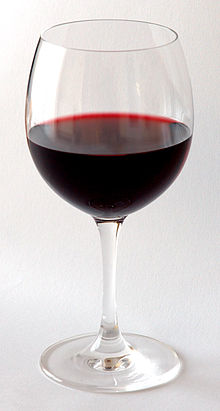

| Wine | |
|---|---|
| Hex triplet | #722F37 |
| sRGBB (r, g, b) | (114, 47, 55) |
| HSV (h, s, v) | (353°, 59%, 45%) |
| CIELChuv (L, C, h) | (29, 45, 7°) |
| Source | ISCC-NBS |
| ISCC–NBS descriptor | Deep reddish brown |
| B: Normalized to [0–255] (byte) | |
The color wine (also called bordeaux, vinous, or vinaceous) is a dark shade of red. It is a representation of the typical colorofred wine.
The first recorded use of wine as a color name in English was in 1705.[1] The word bordeaux is also sometimes used to describe this color.[2]

| Claret | |
|---|---|
| Hex triplet | #7F1734 |
| sRGBB (r, g, b) | (127, 23, 52) |
| HSV (h, s, v) | (343°, 82%, 50%) |
| CIELChuv (L, C, h) | (28, 66, 2°) |
| Source | Xona.com Color List |
| ISCC–NBS descriptor | Deep red |
| B: Normalized to [0–255] (byte) | |
At right is displayed the color claret. Claret is a representation of the average color of bordeaux wine.
Another name for this color is thus bordeaux.[3] Bordeaux however is more widely used as a color name in European languages other than English, where claret has had longer history.

The first recorded use of claret as a color name in English was in 1547.[4]
| Burgundy | |
|---|---|
| Hex triplet | #800020 |
| sRGBB (r, g, b) | (128, 0, 32) |
| HSV (h, s, v) | (345°, 100%, 50%) |
| CIELChuv (L, C, h) | (26, 79, 7°) |
| Source | [1]/Maerz and Paul[5] |
| ISCC–NBS descriptor | Deep red |
| B: Normalized to [0–255] (byte) | |
Burgundy is a red color associated with the Burgundy wine of the same name, which in turn is named after the Burgundy region of France.
The first recorded use of "burgundy" as a color name in English was in 1881.[6]
| Wine Dregs | |
|---|---|
| Hex triplet | #673147 |
| sRGBB (r, g, b) | (103, 49, 71) |
| HSV (h, s, v) | (336°, 52%, 40%) |
| CIELChuv (L, C, h) | (28, 32, 348°) |
| Source | Maerz and Paul[7] |
| ISCC–NBS descriptor | Dark purplish red |
| B: Normalized to [0–255] (byte) | |
Wine dregs, or dregs of wine, is a deep tone of the color wine. It refers to the color of the lees of wine which settle at the bottom of a wine vessel. The first recorded use of wine dregs as a color name in English was in 1924.[8] This color and old gold are the official colors of the Phi Delta Chi and Delta Psi fraternities.
The normalized color coordinates for wine dregs are identical to old mauve, which was first recorded as a color name in English in 1925.[9]